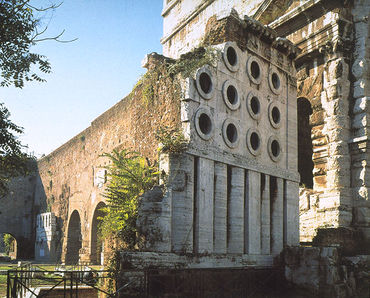Sodalitas
Home | Latíné | Deutsch | Español | Français | Italiano | Magyar | Português | Română | Русский | English
⚜⚜⚜ Site Index - Key Pages ⚜⚜⚜
Several state-sponsored public collegia (sing. collegium) and several aedilician private sodalitates (sing. sodalitas), exist within Nova Roma for the discussion of topics of special interests to Nova Roma citizens. These special interest groups or associations are operated independently, often through their own forums or mailing lists.
- Richard S. Ascough Forms of Commensality in Greco-Roman Associations (DRAFT paper for the SBL Greco-Roman Meals Consultation) PDF
Per the lex Cassia de creatione sodalitatum and the more recent Lex Caecilia de collegis et sodaliciis, any group of citizens may petition the Senate to create a collegium, or the aediles for a sodalitas. A collegium group should first form and operate informally for at least six months. After that, the Senate will consider recognizing it.
Collegium Sodalitas Barbarica
The Collegium Sodalitas Barbarica formed with the purpose of studying topics such as foreign cults and religions, “barbarian” languages & literature, material culture such as clothing, jewelry and household items, barbarian military & reenactment, historical events, and the adoption of Romanitas.
Collegium Sodalitas Iurisprudentium
The Collegium Iurisprudentium is dedicated to the study of ancient Roman law and its application in Nova Roma. The Collegium aims to provide a service to the Res Publica by offering subject matter expertise to magistratus and cives alike. Offering advocate and jurist training programs as well as legislative editing services, the collegium focuses discussions and legal tasking through the experience of past and present senior magistratus and officers, like the decemviri stlitibus iudicandis.
Collegium Sodalitas Coquorum et Cerevisiae Coctorum
Collegium Sodalitas Coquorum et Cerevisiae Coctorum is devoted to all aspects of food drink and dining in Roma Antiqua.
Collegium Sodalitas Egressus
The Collegium Sodalitas Egressus promotes our Republic and establishes person-to-person contact of cives of Nova Roma with other organizations of Roman-related interests.
Collegium Sodalitas Graeciae
The Collegium Sodalitas Graeciae is dedicated to enriching Nova Roma with knowledge and discussion of the Ancient Greek world.
Collegium Sodalitas Latinitatis
A place to discuss the Latin language, Latin literature and Classical philology, along with the promotion of Latinity in Nova Roma. Messages in Latin and other languages are welcome. Collegium Sodalitas Latinitatis
Collegium Sodalitas Militarium
Members of Collegium Sodalitas Militarium discuss and study aspects of the Roman Military with focus on Infantry, Cavalry, Naval, Engineering and Cartography.
Collegium Sodalitas Munerum
Nova Roman citizens interested in the art of gladiatorial combat and related entertainments as practiced in ancient Rome. Collegium Sodalitas Munerum
Collegium Sodalitas Musarum
The Sodalitas Musarum, under the patronage of Apollo and the Nine Muses, endeavours to develop and serve the cultural and artistic life of Nova Roma. Learn more ...
